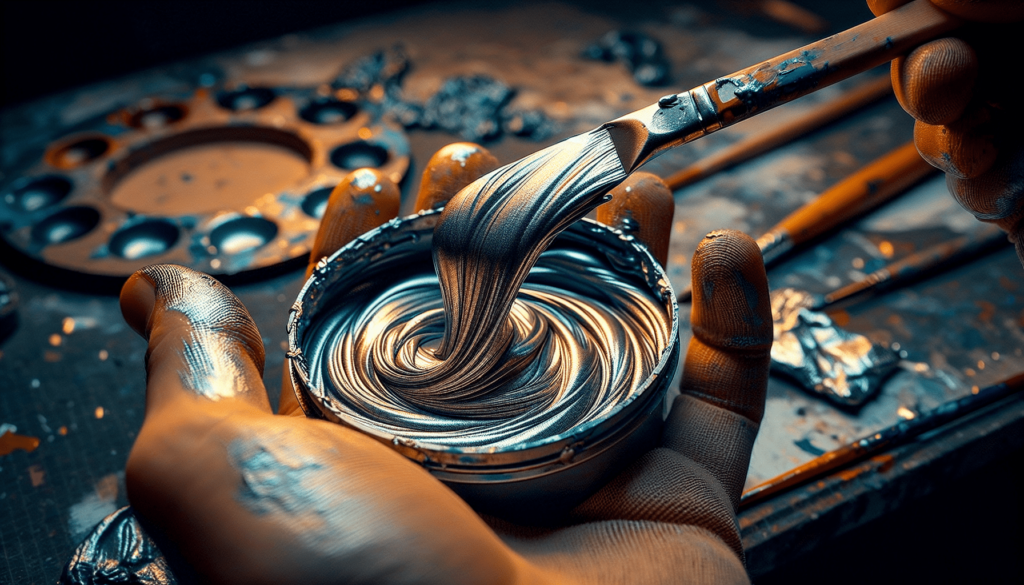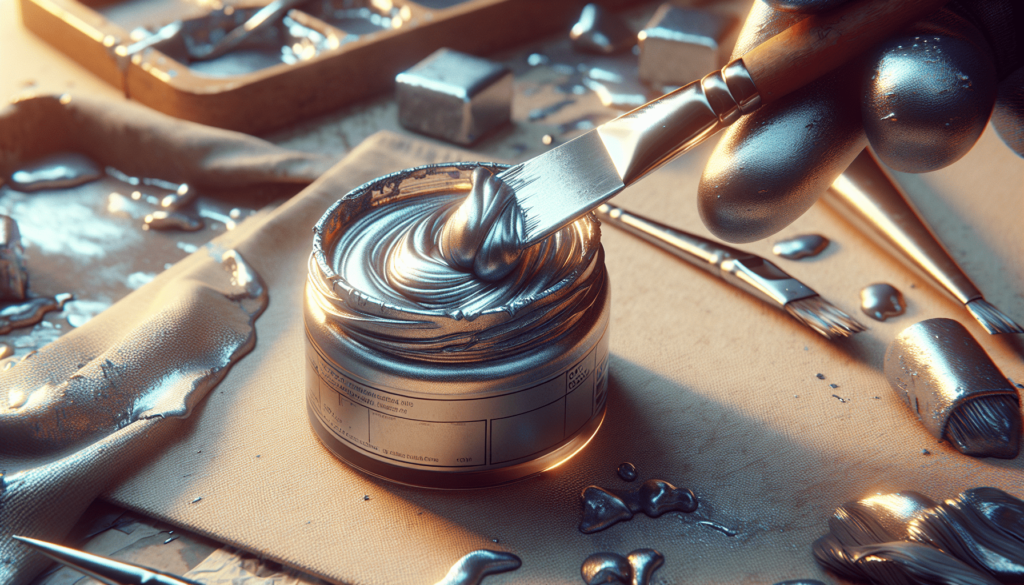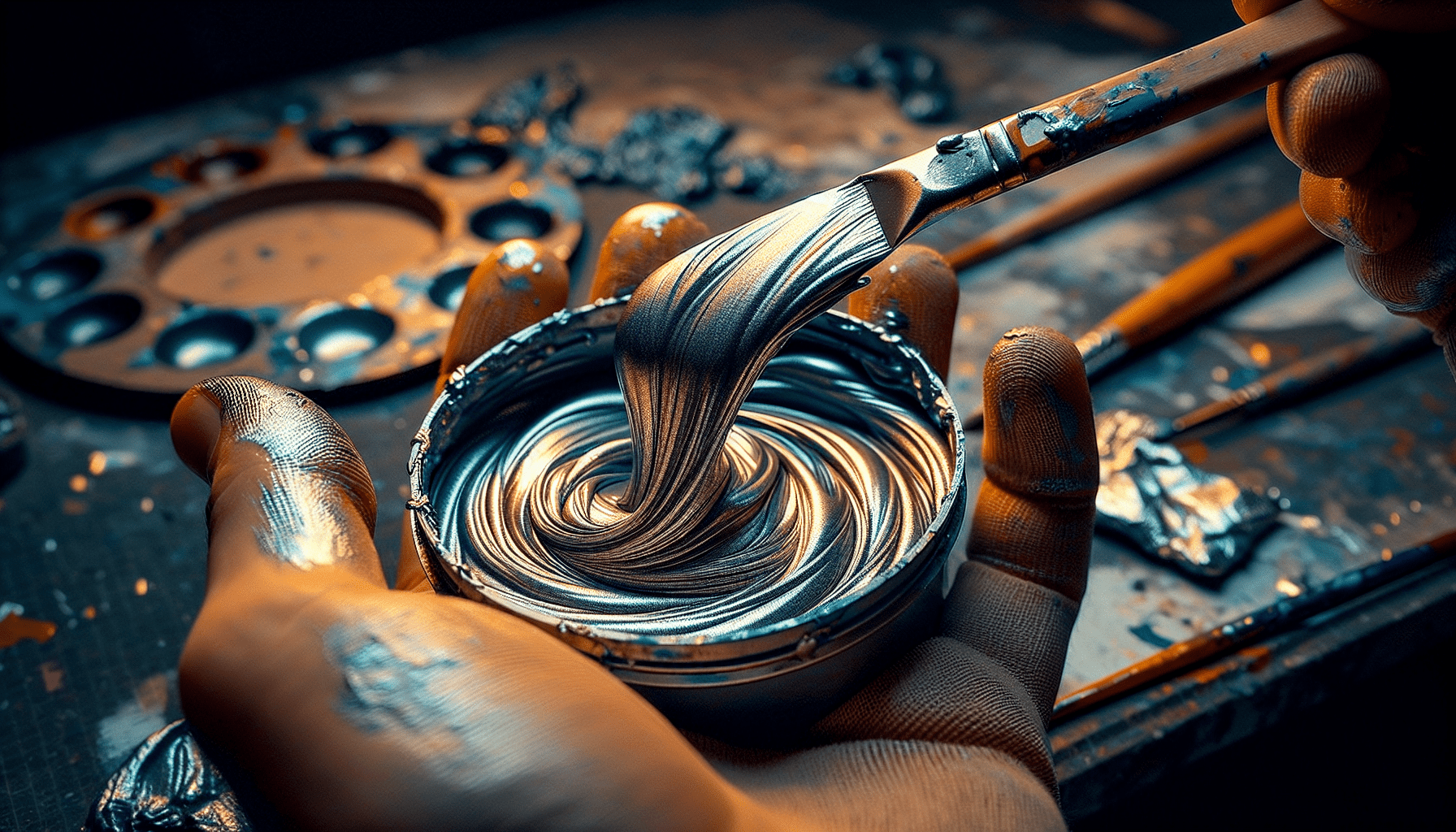How do you thicken metallic paint for your various projects? This question is quite common among both novice and experienced DIY enthusiasts, especially when the desired effect requires a thicker application. Whether you’re working on a wall, an art piece, or any other surface that demands metallic paint, achieving the right consistency can make all the difference. However, thickening metallic paint is not always straightforward, and doing it wrong can lead to unsatisfactory results.

Understanding Metallic Paint
What is Metallic Paint?
Metallic paint contains small metallic particles that give the painted surface a shimmering or glittering effect. Often used for automotive finishes, furniture, and decorative art, metallic paint adds depth and dimension to any surface. Its unique reflective properties can significantly change the appearance of a surface when viewed from different angles.
Key Components of Metallic Paint
Metallic paint typically consists of the following components:
- Base Paint: This can be either water-based (latex) or oil-based.
- Pigments: These provide the color.
- Metallic Flakes: Tiny, reflective particles that give the paint its metallic sheen.
- Binders: These help the paint adhere to the surface.
- Additives: These can include anything from anti-settling agents to stabilizers.
Why Thicken Metallic Paint?
Thickening metallic paint can be necessary for various reasons:
- Texture: A thicker paint can create unique textures on a surface, enhancing aesthetic appeal.
- Coverage: Thicker paint often has better coverage, reducing the number of coats needed.
- Durability: Thicker layers can provide added durability and protection.
Methods to Thicken Metallic Paint
Thickening metallic paint can be achieved through several methods, each with its own set of advantages and disadvantages. Let’s explore these methods in detail.
Using Thickeners
What are Thickeners?
Thickeners are commercially available additives specifically designed to increase the viscosity of paint without altering its color or metallic properties.
Types of Thickeners
-
Cellulose-Based Thickeners:
- Commonly used for water-based paints.
- Examples include hydroxyethyl cellulose (HEC).
-
Acrylic Thickeners:
- Suitable for both water-based and oil-based paints.
- Provide a clear, glossy finish.
-
Clay-Based Thickeners:
- Excellent for textured finishes.
- Often used in custom art projects.
How to Use Thickeners
| Step | Action |
|---|---|
| 1 | Choose a thickener compatible with your paint type. |
| 2 | Gradually add the thickener to the paint while stirring continuously. |
| 3 | Monitor the consistency, adding more thickener as needed. |
| 4 | Test the paint on a sample surface before application. |
Using Common Household Items
Cornstarch
Cornstarch is easily available and can be used to thicken water-based metallic paints effectively.
| Step | Action |
|---|---|
| 1 | Mix cornstarch with cold water to form a smooth paste. |
| 2 | Slowly add this mixture to your paint while stirring continuously. |
| 3 | Adjust the consistency by adding more cornstarch paste as needed. |
Flour
Another household item that can be used to thicken paint is flour. However, it is best suited for small, temporary projects.
| Step | Action |
|---|---|
| 1 | Mix flour with cold water to form a paste. |
| 2 | Gradually add this paste to the paint, stirring constantly. |
| 3 | Test the consistency and adjust as needed. |
Reducing Liquid Content
Evaporation Method
Allowing some of the liquid content of your metallic paint to evaporate can also increase its thickness.
| Step | Action |
|---|---|
| 1 | Leave the paint container open for a few hours. |
| 2 | Stir periodically to ensure even thickening. |
| 3 | Close the container once the desired consistency is achieved. |
Straining Method
Straining the metallic paint through a mesh can help remove excess liquid, thereby thickening it.
| Step | Action |
|---|---|
| 1 | Pour the metallic paint through a fine-mesh strainer. |
| 2 | Allow the liquid to drain completely. |
| 3 | Collect the thicker paint left in the strainer. |
Using Binding Agents
Binding agents, often used in professional painting, can also help thicken metallic paint effectively.
Types of Binding Agents
-
Acrylic Gel Medium:
- Compatible with water-based paints.
- Provides a glossy or matte finish.
-
Linseed Oil:
- Suitable for oil-based paints.
- Adds flexibility and durability.
How to Use Binding Agents
| Step | Action |
|---|---|
| 1 | Choose a binding agent compatible with your paint type. |
| 2 | Gradually add the binding agent while stirring the paint. |
| 3 | Test the paint on a sample surface to verify the consistency. |
| 4 | Adjust as necessary. |
Practical Tips and Precautions
Testing the Consistency
Always test the thickened paint on a small, inconspicuous area before proceeding with the main project. This ensures you achieve the desired effect without ruining your work.
Stirring and Mixing
Proper mixing is crucial when thickening paint. Be sure to stir continuously and evenly to avoid lumps and inconsistencies.
Safety Precautions
- Ventilation: Ensure good ventilation when working with paint to avoid inhaling fumes.
- Protective Gear: Wear gloves and masks to protect your skin and respiratory system.
Shelf Life
Thickened paints generally have a shorter shelf life. Store any leftover paint in a tightly sealed container and use it within a few weeks.
Troubleshooting Common Issues
Uneven Consistency
If you find that the paint is not evenly thickened, it may be due to insufficient mixing. In such cases, transfer the paint to a larger container and mix thoroughly.
Clumping
If the paint forms clumps, strain it through a fine-mesh strainer to remove any solid particles. Adding a small amount of water or solvent and stirring briskly can also help.
Loss of Metallic Sheen
In some cases, thickening the paint might dull its metallic sheen. To counteract this, you can add a clear glossy medium to restore the shine.
Differing Dry Times
Thickened paint may have different drying times compared to its original consistency. Be patient and allow extra time for each coat to dry thoroughly.

Advanced Techniques and Use Cases
Textured Finishes
Thickened metallic paint is excellent for creating textured finishes. Use specialized tools like sponges, brushes, or trowels to achieve diverse effects.
Layering
You can achieve unique multi-dimensional effects by layering thickened metallic paint. Apply one layer, allow it to dry, and then add another layer using complementary or contrasting colors.
Mixed Media Art
Incorporate thickened metallic paint into mixed media art projects to add an extra layer of depth and complexity. Combine it with other materials like fabric, paper, or wood for stunning results.
Conclusion
Understanding how to thicken metallic paint opens up a myriad of creative possibilities for your projects. Whether you choose to use commercial thickeners, household items, or binding agents, each method has its own set of advantages and can help you achieve the desired consistency and finish. Always remember to test your results, follow safety precautions, and store unused paint properly to maintain its quality. Happy painting!



